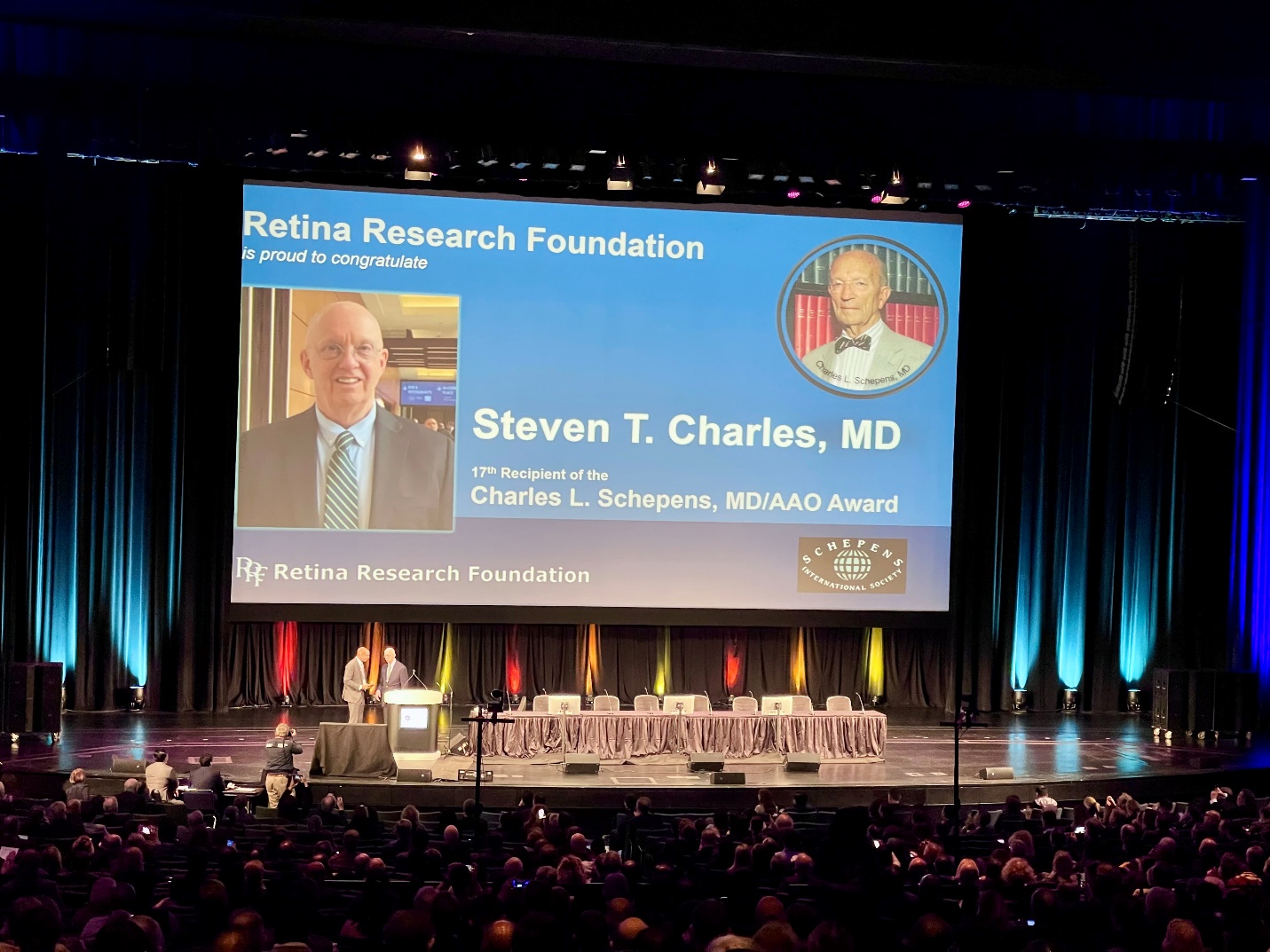Lindsay Kozek, MD, PhD and Melissa Yuan, MD
Massachusetts Eye and Ear, Boston, MA
The Charles L. Schepens lecture, given annually at the American Academy of Ophthalmology meeting in honor of Dr. Schepens, “the father of modern retina surgery,” and inventor of the binocular indirect ophthalmoscope. This year the lecture was presented by surgeon, engineer, and innovator Dr. Steven Charles on Friday morning at AAO, following the conclusion of the previous session moderated by Dr. Paul Sternberg. Dr. Sternberg handed the microphone over to Dr. Stephen McLeod, CEO of the Academy, to introduce “one of our heroes – Steve Charles.”
Dr. McLeod outlined Dr. Charles’ impressive career, noting his contributions to vitreoretinal surgery, including nearly 50,000 surgeries performedBye-bye , over 200 issued or pending patents, and his pivotal role in developing surgical technologies used worldwide. Dr. Charles’ innovations extend beyond ophthalmology, having influenced surgical robotics in fields spanning from orthopedics to neurosurgery. He has received numerous accolades, including the Hermann Wacker Prize of the Club Jules Gonin and the ASRS Founders Award.

Dr. Charles began his talk, titled “Systems Engineering at the Intersection of Technology and Technique,” with a touch of humor, recalling that he was “almost as nervous now as when Schepens observed me operating 50 years ago.” He paid tribute to Dr. Schepens, a “tediously great surgeon,” who established the retina subspecialty.
Drawing on his engineering background, Dr. Charles emphasized the crucial intersection of engineering and surgery, highlighting the importance of the collaborative process. He noted that the development of techniques and technologies is interdependent and thus both must evolve together. He pointed out that great ideas do not come from committees, but from conversations between surgeons and small groups of engineers. As surgical technology has become more complex, the need for multidisciplinary engineering teams has grown. Dr. Charles stressed the importance of close collaboration between surgeons and engineers, stating, “Engineers don’t know medicine, and surgeons don’t know engineering—you’ve got to do both to get it right.”
He also addressed the role of medical device companies, underscoring the importance of ethical and transparent partnerships. These companies provide substantial capital for research and development, which is increasingly crucial as the complexity and cost of developing new technology increase.
To illustrate the impact of collaboration, Dr. Charles celebrated milestones in retina surgery, starting with Robert Machemer and Jean Marie Parel’s development of pars plana vitrectomy and Conor O’Malley and Ralph Heintz’s creation of the three-port vitrectomy system. He also humbly reflected on his own influential work, including contributions to endophotocoagulation, linear suction, and the development of the disposable, self-sharpening cutter.
![]()
Dr. Charles then delved into the evolution of vitrectomy technology. He recalled the early days when vitrectomy cutters operated at 200 cuts per minute, compared to today’s devices, which achieve up to 30,000 cuts per minute. He detailed the reduction in cutter weight from 900 grams to just 5.32 grams, the shrinking gauge sizes from 17G to 27G, and the advancements in fluidics, with response times plummeting from over two seconds to a mere five milliseconds.
He walked the audience through the progression of fluidics, from early manual syringe aspiration by an assistant to the development of foot pedal-controlled systems, which enabled more precise and responsive aspiration, controlled by the surgeon. He discussed how this evolution paralleled advancements in membrane peeling, from using bent needles, as Dr. Machemer did in 1972, to modern ILM forceps that are lightweight and disposable, ensuring reliability. Dr. Charles also highlighted the innovations in air and gas injection, drainage of subretinal fluid, and vitrectomy port technology.
The transition from single-port to three-port vitrectomy marked a significant turning point in the field. Dr. Charles credited pioneers like Conor O’Malley, Dyson Hickingbotham, and others for refining techniques and systems. He also shared insights into his own surgical innovations in PVR management, such as inside-out membrane peeling and retinectomy.
Finally, Dr. Charles touched on the evolution of retinopexy, hemostasis, and PRP, which have shifted from older methods like trans-scleral cryopexy and diathermy to safer, more precise endophotocoagulation techniques.
Throughout his lecture, Dr. Charles emphasized the problem-solving mindset that drives innovation, explaining the rationale behind each technological leap and its impact on the field. He concluded by expressing his gratitude to the Academy and the selection committee for the honor of delivering the Schepens lecture, which was received with thunderous applause from the standing-room-only crowd.